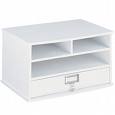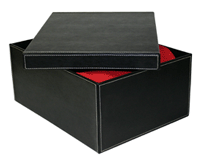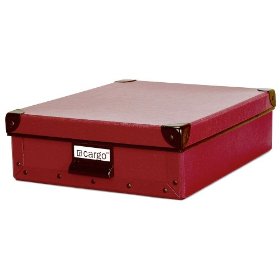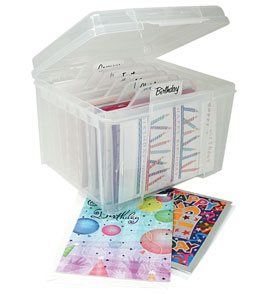Paper Manners Matter: Cut Card Clutter & Store Social Stationery
In my field, we often find that disorganization is the symptom of a bigger issue. For example, when parents bemoan that our hard work is for naught because the kids will fuss and fume and refuse to follow any organizing rules (even those created with their own input), it ceases to be an organizing issue. It’s a parenting issue.
When a client is pleased with the financial files we’ve organized and the debt-reduction plan we’ve designed, but reports back that the spouse is unwilling to discuss finances, bring home receipts or stop spending money they can’t afford, it’s not about the clutter. It’s a marital (and communications) issue.
And when we unearth oodles of stationery and cards that have never been touched, it may just be a simple session of decision-making, purging, sorting and storing. Is it paper goods addiction or something more?
It’s understandable why people don’t write letters anymore. The messages of daily life are more easily and quickly delivered by phone, tweet or text, and all for less than the cost of a stamp. Paper Doll gets that nobody has the time or inclination to pen:
My Dearest Friend,
…should I draw you the picture of my heart it would be what I hope you would still love though it contained nothing new. The early possession you obtained there, and the absolute power you have obtained over it, leaves not the smallest space unoccupied. I look back to the early days of our acquaintance and friendship as to the days of love and innocence, and, with an indescribable pleasure, I have seen near a score of years roll over our heads with an affection heightened and improved by time, nor have the dreary years of absence in the smallest degree effaced from my mind the image of the dear untitled man to whom I gave my heart.
(Abigail Adams to John Adams, December 23, 1782)
We’re busy. We feel silly being flowery. Postage is ridiculously expensive. But ask yourself, honestly:
- Would you rather receive a hand-written love letter or get a Twitter tweet that says “I <3 you”?
- Can a shout out on your Facebook wall really replace a cheery, heartfelt Get Well card when you’re recuperating from surgery?
- Might anyone possibly think it’s OK to send a message of condolence via text?
Paper Doll may seem hopelessly old fashioned (and at odds with my mission of minimizing paper clutter) by promoting paper communication in the age of the Kindle. But there are worse things than being old fashioned.
So why do people have piles of note cards and stationery that they don’t use? The explanations crisscross the fields of organization and etiquette. Why might you have oodles of unused stationery?
1) You forget the events for which cards should/can be sent.
Open your address/phone book and identify the people whose birthdays, anniversaries and (repeating) special days you’d really like to remember. If you know the dates, put the information on the perpetual calendar that came with your daily planner or plug them into your PDA. If you don’t know the dates, let go of the embarrassment and find out. I’m sure your friends would rather have you say “You know how terrible my memory is–when’s your birthday again?” just once, rather than receive belated cards each year. (If you’re really loathe to ask, check the “Info” section of their Facebook page or ask your embarrassment-free kids or spouse to play Sherlock Holmes.)
If you have a lot of people on your list and you use a Tickler File (and you know I think you really should), hand-write (or make a printable spreadsheet) with the names, occasions and special dates, and pop them in the appropriate month slot. Make a note on your calendar for the first day of the month, and then sometime in the middle, to check to see whose special days are coming up…then use up those cards you have before heading out to buy the ones that are occasion-specific.
2) You fear you don’t have the right kinds of stationery.
Haunted by the cobwebby etiquette directives of the 19th and 20th centuries? Yes, there are officially “correct” types of stationery you’re supposed to have. It’s called a stationery wardrobe, and like a traditional clothing wardrobe, what you own often depends on your gender and stage of life. Yet even Miss Manners doesn’t believe one needs to acquire all of the items allegedly required for a classic stationery wardrobe.
The official word from Crane, the biggest wigs of stationery bigwigs, is that women’s personal stationery wardrobes include(d) letter sheets (trust me, you don’t have these), correspondence sheets, monarch sheets, fold-over notes, monograms, informals (that aren‘t informal), correspondence cards and house stationery (in case, one supposes, your house wants to invite that cute condo out for lunch). The official stationery wardrobe for men is far less complex, as men were assumed to be busying their pretty heads with business and not social niceties.
If you truly care about classic etiquette, get yourself to Amy Vanderbilt. And certainly, if you’re a high enough muckety-muck that you have your own protocol officer or you’re having a formal wedding, you’ll need all the formal, matching paperwork. However, if you just want paper that will keep Aunt Gertrude from looking at you askance, I advise:
Get fold-over note cards in ecru. (It’s sort of a light beige. You’ll know it when you see it.)
Really, that’s all you need. Unless you move in fancy circles, off-the-shelf cards are fine, especially if you’re youngish. At some point, invest a small amount of money in cards embossed, engraved or thermographically printed with your name or initials. For formal social occasions (messages of gratitude or condolence, in particular), these will suffice. (Of course, in my best Miss Manners’ Younger Cousin voice, I’m asking “you do know the difference between social and business correspondence, don’t you?”)
All those other goofy cards with pictures of animals or emblazoned with cartoons? If you’ve been using them all along for informal social notes, keep on. However, if you’ve just been collecting them and letting them gather dust, it’s time to purge the clutter. Some ideas for what to do with cards you won’t ever use socially:
- Write notes to put in your child’s lunchbox or (unstamped) in the mailbox for “Special Delivery.” The younger your child is, the more of a treat it will be to have mail of his or her own, especially with a message of encouragement on a day of tests or tryouts.
- Donate colorful stationery to local daycare providers for Arts & Crafts.
- Leave a box of cards in the ICU waiting room of your local hospital with a note saying “take one”. Often, family members would like to leave a note of gratitude for a caregiver or aid, but will having nothing upon which to write.
- Donate unused boxes of stationery or cards to non-profit thrift stores or charity shops.
- Set free the picture postcards you’d otherwise never use, via Postcrossing.

- (Once you sign up, you’ll get an address and Postcard ID, and then be able to surprise some participant with a postcard from a place that seems exotic to them (even if it’s just down the road from you). You’ll end up receiving postcards, too. Enjoy, then toss!
3) Your stationery is so disorganized that you forget what you have or can’t find what you need when you need it.
Typical stationery errors include:
- Mixing unused cards with signed cards you’ve received
- Mixing blank cards with occasion/message cards
- Having multiple places (but no one home) for all your cards and stationery
- Storing cards in inconvenient, inaccessible or forgettable locations
- Keeping card or stationery sets received as gifts (or as inducements to donate to charity) which you don’t like and won’t ever send
So, gather up all of your own personal paper wardrobe from hither and yon. Be ruthless about letting go of cards you know you’d really never send, and set them free (using the tips in #2).
Next, sort the cards and stationery by occasion: birthday cards, anniversary cards, religious/cultural occasion cards (sort by religion or occasion, depending on whether you go to billions of Bar Mitzvahs or quantities of quinceaneras) and blank cards. If you really do write lots of social notes, consider sorting the blank cards by theme (animals, cartoons) or mood (from frivolous to serious), so you can quickly pick what you need.
Finally, pick a storage framework and location that fits your personality. If you’re a busy mom with barely enough time to write, let alone dust an ornate stationery credenza,

be fair to yourself and skip a complex system. A drawer in your desk or bedside table, near where you’re likely to do the writing, should be fine.
If you prefer to be mobile, some simple but attractive all-purpose leather, cardboard, or plastic containers and stackable boxes offer dual-purpose dcor/storage that you can carry to your preferred writing spot:


4) You are more attached to keeping the cards than sending them.
Stationery is a DIY gift–just add words and give away.
But sometimes, a note card or piece of stationery bears a photo or message that so completely captivates us, we can’t bear to let go. The pain of never seeing the photo again outweighs the pleasure the note might bring your recipient. We’re toddlers refusing to share our toys.
The solution? Frame the card and display where it will give you ongoing joy, even on a wall hidden from general view, if it won’t match your dcor. Sometimes, you’ve got to give yourself the gift.
5) You don’t know what to say or how to say it, so you say nothing.
When gratitude or condolences are due, silence is inexcusable. It really is the thought that counts, so in most cases, just speak from the heart. However, if even the idea of expressing your thoughts makes you queasy, the web has you covered. The following sites (or a quick Googling) will help you figure out what to say and how to say it:
My Thank You Site – The creator provides guidance on everything from selecting useful phrases to express gratitude and sympathy to tips on wording lengthier messages.
Thank You Note Samples – This site walks you through showing gratitude for everything from shower and wedding gifts (including money) to hospitality and acts of kindness.
About.com – reviews the elements of writing a condolence letter, from salutation to signature and all the awkward lines in between.
e-How – explains how to write a thank-you letter for wedding gifts. (Print or forward it for your new spouse so you can share the gratitude duties!)
Emily Post – The etiquette expert walks you through the salient points of thank-you notes for children of every age.
Clear the clutter, sort the stationery, write the words. You’re welcome.





Follow Me